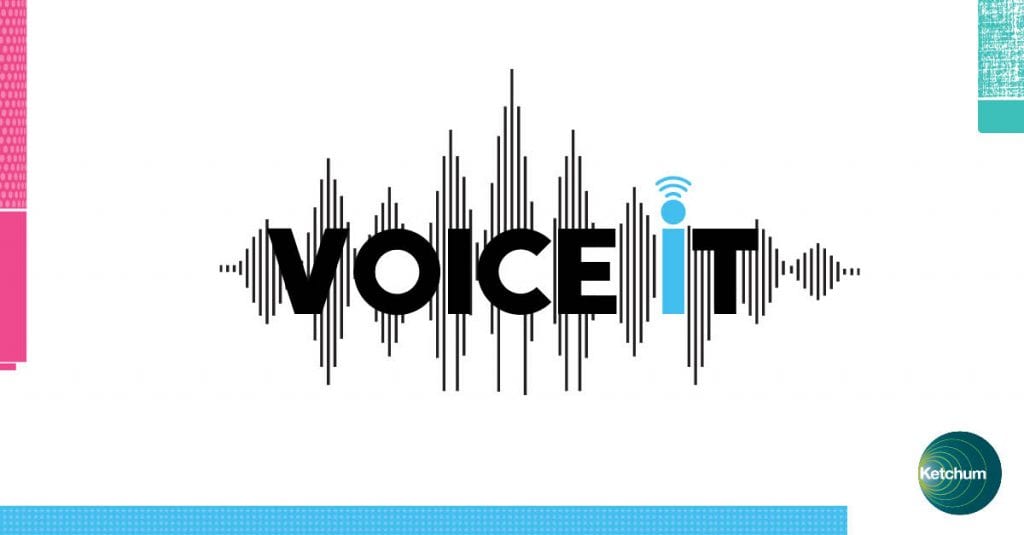As of January 2018, almost 20 percent of adults in the U.S. own a smart speaker. That’s a staggering statistic when you consider that adoption is expected to grow by nearly 50 percent before the end of the year! That means we may soon talk to an AI assistant more frequently than our own family members. Crazy thought, right?

Voice-enabled devices (e.g., Amazon Echo, Google Home, Apple HomePod, etc.), and the AI software that powers them, are the fastest growing technologies in the marketplace right now. Their presence isn’t a trend – it’s here to stay. So much so, that one of the key elements of the agenda at the Cannes International Festival of Creativity taking place this week is voice marketing, with Amazon expected to have a large presence at the festival to talk about their technology. The fact that Voice is so prominently featured on the agenda should be a clear indication of how quickly it’ll inspire agencies and clients alike to learn and adopt voice marketing strategies.
Voice is well beyond the fad stage. As the technology continues to grow, the ability for the underlying AI software to better recognize natural language – and learn – represents a major opportunity for brands to build more engaging customer relationships.
If you’re a brand marketer, your consumer base is adopting this technology at a quick pace and you have an opportunity to be right there with them – or even a step ahead. Here are three main reasons why you should act on voice marketing now:
Voice is the way of the future – and the future is now.
As brands create content for a new medium, it validates the success and fuels the growth of that new technology or platform. Nearly a decade ago, the advent of social media and mobile apps put a brand’s experience directly into consumers’ hands. Voice marketing for brands is the next wave to build upon and deepen those relationships. In fact, voice marketing is just about at that same inflection point as mobile app development was at the advent of smartphones. According to an article from Tech Crunch in 2016, there were about 5,000 active apps in the App Store in 2008. Today, we’re at almost three million active apps in the App Store – that’s an almost a 60,000 percent increase in 10 years’ time!
Where voice is unique to mobile apps is that brands can now create a frictionless extension (who wants to fish their phone out of their pocket, unlock their device, swipe to an app and open it, anyhow?) of themselves to showcase new products, offerings or incentives to generate sales or even just sustain community and relationships in everyday situations. Voice will inevitably be an asset to all marketers, and it’s important to work out the kinks out now so that you are able to grow into the future with your consumers – and not be one step behind.
It’s more than getting people to buy your product – it’s also about building a relationship with your consumers.
What’s most fascinating about voice assistants is that people are engaging with them as if they were human. While it’s something we’re not totally accustomed to yet, users around the world are saying “please” and “thank you” (and even “sorry”) to this technology. These devices are essentially setting us up to embrace the future as AI begins to take centerstage during this influential shift in society. As Google pointed out, it proves that “people perceive the devices as more than just an electronic toy, they’re more akin to another person or a friend.” Also worth noting is that Google’s Duplex Voice AI application gained a hefty amount of media coverage recently for potentially “passing” the Turing Test. That means that humans who interacted with AI reasonably believed that they were speaking to another human, and not AI – this is a big deal, guys!
For better or for worse, that’s such an important distinction as brands jump into this space. Truly utilizing this technology – and not just creating it for creation’s sake – generates a new, more intimate way that consumers will interact with and perceive your brand and its value. It brings your brand into uncharted territory, which should be even more of a reason to jump on board now.
Voice allows you to create and deliver a broader array of content – across a broader range of channels.
One of the best attributes of voice assistants is that they put the customer experience right at the core of its functionality. Conversation-like interactions bring about more natural responses and higher brand affinity by fulfilling a variety of human needs. Here are six categories that we’ve identified:
- Utilitarian: Your strategy helps to solve an inherent problem
- Storytelling: You want to bring your audience on an engaging journey
- Games: You want to delight your audience with questions and answers
- Whimsical: You want to build an effervescent experience for your audience
- Connected: Straightforward – these are connected devices (e.g. cars, appliances, etc.)
- Current / Corporate: You want to inform your audience
As you can see, the opportunities with voice assistants are endless and continuously evolving – these are just a few of the category examples. Voice marketing is the next era in consumer interaction – and we’re excited to dive into it with you.
Here at Ketchum, we can help you get started through VOICE IT, our new portfolio of voice marketing services that lets brands use voice assistants to interact with consumers in new ways. Our team of VOICE IT specialists work closely with clients to identify the right voice strategy for their marketing needs. From workshops, landscape analysis and audience mapping to tech development, user testing, targeted distribution plans, and ongoing optimization guidance, our team partners with you to deliver the most relevant messages to consumers, via the right “skills” at the most effective times. We can also help you be agile in this new channel as we scale your voice needs to any level of complexity.
Think of mobile phones and how quickly they went from a clunky concept to the remote control for our lives. The future is calling. Can you hear it?



